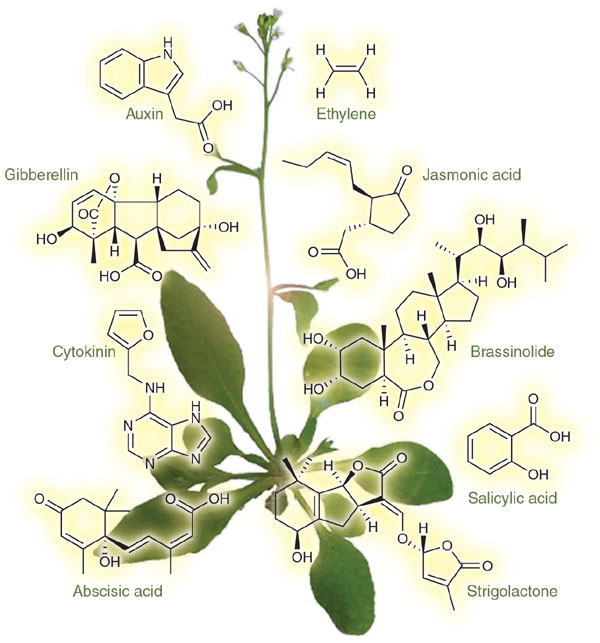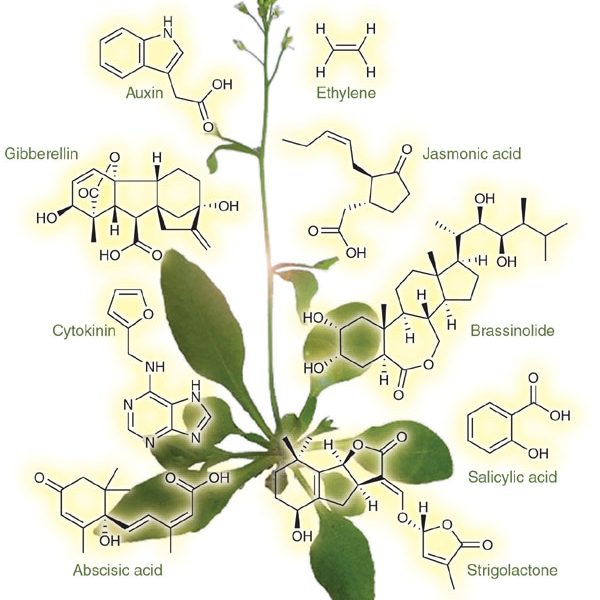Plant hormones are small molecules with no nutritional value that are used as chemical signaler within plants. A hormone will trigger a chemical signaling cascade that will cause the plant to carry out certain specific behavior. This fact has made them one of the most useful tools to manipulate plant growth and improve the yields and quality of many crops, especially flowering plants. This has also made them a key target for hype, with many products promising significant gains without much talk about interactions with other hormones or other fundamental aspects. In this post I want to talk about six things you should know about plant hormones, both to use them more effectively and to adequately manage your expectations when you use them. Note that although plant hormones are considered plant growth regulators (PGRs), this broad class includes other molecules – such as gibberellin synthesis inhibitors – that are not being considered in this post.
Know specifically what you want. A hormone will affect a plant in a very specific way, to achieve a specific purpose. Hormones can help you manipulate plant growth but which one you use depends fundamentally on what you want to achieve. Do you want the plant to be bigger or shorter? Do you want to have more water content in your product? More solid content? More terpenes? Do you want to fight drought conditions? Excess salinity? Insects? The specifics of what you want will guide you into choosing an appropriate hormone for your specific needs.

Plan your hormone applications strategically. Different hormones can stimulate different processes that are needed at different points of a plant’s life. If you plan the use of hormones carefully you can stimulate root growth when plants are transplanted, then stimulate flowering or other behavior when you want the plant to express that behavior more strongly. Plants take some time to steer, they react to their environment, hormone applications at the right times can give a plant a strong signal that it should follow certain behavior and you – as a grower – can ensure that the environmental conditions are perfect for the processes the plant will be carrying out next. Hormones are the flares telling the plant where to go, you should ensure you make that a smooth ride.
There is no free lunch. Plant hormones act to cause a certain behavior to happen, but this behavior comes at a specific cost. A plant that is stimulated to produce more flowers will often grow smaller fruits, a plant that is stimulated to produce more terpenes might produce lower yields because of the additional energy spent in these molecules, a plant that grows more roots, grows less shoots while it’s doing that, etc. A plant does not magically get access to more energy because it has been stimulated with a hormone, it simply chooses to act differently with the energy it is receiving.
Hormones interact with each other. A given hormone can behave in a way when it’s applied and in a very different way when it’s applied with another hormone. As different hormones signal different paths, the net effect is often related with how these different paths are activated. Some are synergistic, the total is more than the sum of the parts, while others are antagonistic, meaning you get less than the sum of the parts. Growers interested in hormones will often make the mistake of applying a lot of things at the same time, but they have no idea what the net effects are going to be like. When dealing with hormones introduce them one at a time and make sure you’re getting a measurable positive effect before you venture into using another one with it. Incremental gains is the name of the game not “apply every hormone under the sun that has a peer reviewed paper published where it increases yields in a plant”.
Concentration is everything. To make things even more complicated, a hormone might activate one signaling path when it’s present at a given concentration but a different one when it’s present at a much larger concentration. Using the wrong concentration for the hormone might end up causing a completely different effect or an effect so pronounced that it’s negative side effects are going to out-do the positive effects. Furthermore, this can also be genetic dependent, so when using hormones on new varieties or species it is always advisable to do a concentration trial across 2-3 orders of magnitude to see where the “sweet spot” for the desired effect is. Sometimes hormones are most effective at surprisingly low concentrations – even 0.1 to 1 ppm – while other times they need to be applied in very significant amounts (100-300 ppm).
The application route and vehicle is very important. A hormone might be very effective when applied in a foliar spray, while completely ineffective when applied in a root drench. Sometimes the hormone requires specific additives or solvents to be used in order to ensure its absorption and others it needs to be applied at a very specific pH range or even just by itself. Knowing the particular application conditions of the hormone you want to use is also important to achieve the expected results.
These are some simple guidelines to consider when using plant hormones in your crop. Hormones are no miracle but they can certainly provide amazing improvements in yields and quality if used appropriately. Formulating a good hormonal regime, with adequately formulated foliar/root drenches, applied at the right times, with the right hormones, can provide amazing results. This however requires a lot of testing, a lot of effort and a lot of understanding about the plant being grown and its crop cycle. Every crop has its own genetic and environmental conditions and requires significant experimentation to achieve the best possible results.





